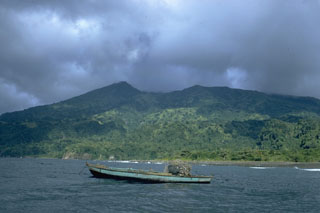Report on Soufriere St. Vincent (Saint Vincent and the Grenadines) — 23 December-29 December 2020
Smithsonian Institution / US Geological Survey
Weekly Volcanic Activity Report, 23 December-29 December 2020
Managing Editor: Sally Sennert.
Please cite this report as:
Global Volcanism Program, 2020. Report on Soufriere St. Vincent (Saint Vincent and the Grenadines) (Sennert, S, ed.). Weekly Volcanic Activity Report, 23 December-29 December 2020. Smithsonian Institution and US Geological Survey.
Soufriere St. Vincent
Saint Vincent and the Grenadines
13.33°N, 61.18°W; summit elev. 1220 m
All times are local (unless otherwise noted)
A new effusive eruption had built a lava dome in the summit crater of Soufrière St. Vincent when observed on 29 December by personnel from the National Emergency Management Organisation (NEMO), St. Vincent and the Grenadines, and the Alert Level was raised to Orange (the second highest level on a four-color scale). The observers noted that the small black-colored dome had grown on the WSW edge of the 1979 lava dome. The University of the West Indies Seismic Research Centre (UWI-SRC) stated in a press briefing that seismicity at the volcano began to increase in early November and changes in the water lake and fumarolic area were noted on 16 December. A persistent thermal anomaly had been identified in satellite data over the previous couple of days, which is what prompted the NEMO field visit.
Geological Summary. Soufrière St. Vincent is the northernmost and youngest volcano on St. Vincent Island. The NE rim of the 1.6-km wide summit crater is cut by a crater formed in 1812. The crater itself lies on the SW margin of a larger 2.2-km-wide caldera, which is breached widely to the SW as a result of slope failure. Frequent explosive eruptions after about 4,300 years ago produced pyroclastic deposits of the Yellow Tephra Formation, which cover much of the island. The first historical eruption took place in 1718; it and the 1812 eruption produced major explosions. Much of the northern end of the island was devastated by a major eruption in 1902 that coincided with the catastrophic Mont Pelée eruption on Martinique. A lava dome was emplaced in the summit crater in 1971 during a strictly effusive eruption, forming an island within a lake that filled the crater. A series of explosive eruptions in 1979 destroyed the 1971 dome and ejected the lake; a new dome was then built.
Sources: University of the West Indies Seismic Research Centre (UWI-SRC), National Emergency Management Organisation (NEMO), Government of Saint Vincent and the Grenadines, Searchlight

